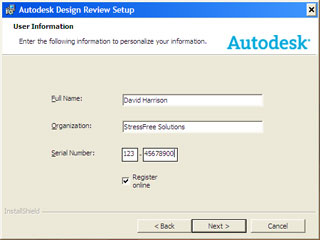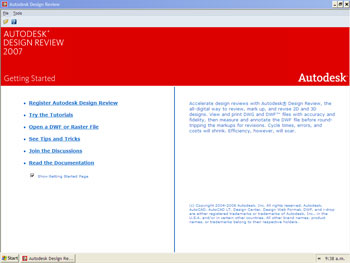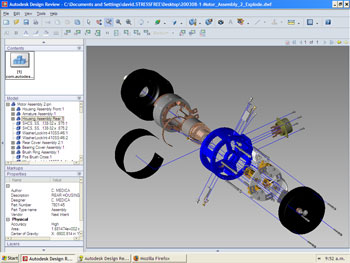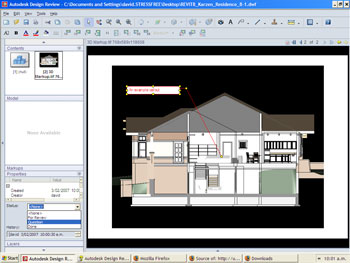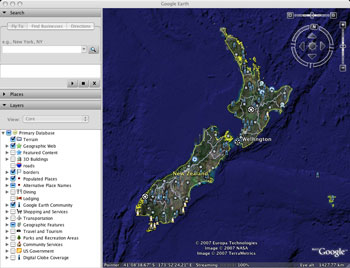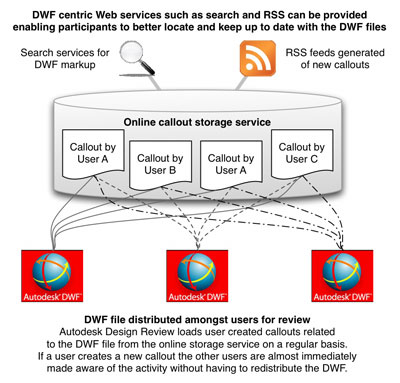Recently Autodesk dropped the price tag off their Autodesk Design Review package making it far more accessible to the Architecture, Engineering and Construction (AEC) industry. Design Review is a DWF-centric tool for viewing and reviewing 2D and 3D design documentation. Prior to becoming freely available Design Review appeared to the casual observer as a useful tool for those heavily into Autodesk products but not the mainstream audience. This pricing shift changes the game and enables the software to compete against Adobe Acrobat as the primary, general purpose viewing tool for design documentation. With this in mind I took a fresh look at the software and what follows is what I found.
Obtaining and Installation
Design Review can be downloaded from the Autodesk website but before you can begin you must provide Autodesk with a few personal and professional details. For what is now free software this seems counter productive as it acts as a barrier to distribution. If you are a software vendor and you want your software tool to become ubiquitous so that your format becomes dominant in the industry (i.e. like Flash and PDF) your software needs to be easily accessible and preferably available from a range of download sites (i.e. download.com).
Just to make things even more convoluted you must take note of a serial number discretely printed on the download page, then browse to another web page altogether to obtain the highly recommended Service Pack 1 installer. Maybe it is just me but if you are going to the effort of heavily publicising your now free product wouldn't it also be a good idea to help this flood of new users out by slipstreaming the service pack into the installer and removing the need for a serial number? Hopefully with the release of Autodesk Design Review 2008 in April these things get cleared up, because if Design Review is to really take off (which I think it could) it has to be painless to attain and install. And please Autodesk if you are listening drop the idea of a 'Service Pack' for a product with a yearly update cycle, either get it right the first time or integrate an automated update mechanism within the program like most software vendors are doing these days.
Finally getting into it
Things get a lot better once you move past the overly painful installation process. On opening Autodesk Design Review you are presented with a clear set of options that help you get working with documents or learn the program.
Interface wise Design Review feels like Adobe Reader crossed with an slim version of AutoCAD. To avoid cutting into the functionality of other products Design Review is not intended as a content creation tool and instead focuses on the viewing and annotating of documents primary created by CAD or BIM software such as Autodesk Revit. Those familiar with Autodesk products will feel right at home with the interface as it borrows significantly from AutoCAD right down to the appearance of many icons. For existing Autodesk users this is great for productivity but for those used to a competitor's product or who have not used CAD coming to grips with some Autodesk axioms can take a lot of time and patience.
Design Review supports 2D/3D files in DWF format and a wide variety of 2D raster file types such as TIFF and JPEG. Design Review can also import DWG and DXF data into a new or existing DWF file. This is a useful capability to have during collaboration as it means the DWF becomes a bi-directional platform for information, quite unlike PDF which are fairly static without the purchase of a costly editing tool like Adobe Acrobat Professional.
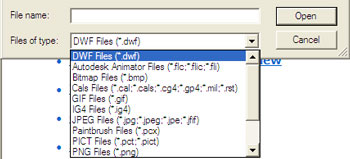
The File -> Open dialog illustrating most of the supported formats
When a DWF file is opened you can browse through the various layers, objects and views. This allows the user to quickly locate or hide aspects of the document when taking measurements or annotating. Like most Autodesk products Design Review utilises side-panel to display the properties of a selected object and a run-down of a document's annotations. Again this is all very familiar territory if you are an Autodesk user but somewhat overwhelming if new to the product line or CAD in general.
Collaborating with Design Review
As the name of the product suggests its core functionality lies in reviewing designs. The review process takes place through a very capable callout system which enables users to highlight aspects of the design for commenting on or questioning. The DWF can be then saved and sent back to its original source for these questions to be answered. Design Review does a fairly good job of tracking all of this activity chronologically so it is easy to see who said what and when. However from a usability perspective it is a little confusing that when creating a comment it is referred to as a 'Callout' but on the side-panel these comments are listed as 'Markups'. This is a small thing by why the terminology change when a single term could be consistently applied?
Once you get the hang of creating callouts it is a fairly painless process to visually identify a design issue, comment upon it and email the modified file to the intended recipient. There is an email option direct from Design Review but it would be nice to see a toolbar button for this (as in Adobe Reader) so people do not have to look for it halfway down the File menu. Unsurprisingly Design Review has built in Buzzsaw support for opening from and saving to Autodesk's on-line service. What is a little surprising is that there is no direct promotion of Buzzsaw within Design Review. Considering the two go hand in hand together it would make sense to include an easy sign up function built into the software in the same manner Apple promotes the .Mac service within their own product lines.
A promising beginning but there is room for improvement
As a commercially priced piece of software Design Review only made sense for large or long term design teams with an established suite of Autodesk applications. However with this significant shift to a free model Design Review suddenly becomes a viable tool for nearly all AEC professionals seeking to digitally collaborate in a medium that has the accessibility of paper plans and the clarity of CAD. With this in mind I think there exists a number of areas where Autodesk Design Review needs to improve or change to fully realise its potential.
The installation
For clients and other non-technically inclined users to use from the comfort of their own desktop it must be as simple to attain as downloading a single, easily located file and mindlessly running an installer that asks nothing more than do you want to accept the default installation directory? No serial code, no service pack and certainly no system restarts.
The interface
Autodesk Design Review inherits its interface from a long lineage of Autodesk products. If you are a die hard Autodesk user is not such a bad thing, but if Autodesk is seeking to extend the use of Design Review beyond this tightly controlled customer base they need to give a second thought to the interface. To reach its full potential Design Review should be accessible to users of all technical abilities and software backgrounds. It is counter-productive to adopt an ugly and often confusing historical interface when in fact Design Review is not an extension of the AutoCAD franchise but the creation of an entirely new product line.
How could things be improved? For starters they could take a look at the way Google Earth handles 3D navigation and take a leaf from that. Setting up a view should not involve clicking on nested icons to achieve tasks that should be accessible in a far more intuitive manner. This would result in a new interface paradigm but as Microsoft has illustrated with Office 2007 such events can be beneficial. Through providing a dynamic toolbar the little utilised menu strip could be disabled in a similar manner to Internet Explorer 7, providing even more screen space for document viewing (the purpose of the application).
By default there is also far too much screen clutter for an application that is meant to be all about reviewing designs. There are too many toolbar icons visible especially considering half of them are generally disabled. The interface would be so much clearer if the interface was dynamic to suit your current task (i.e. like Office 2007 and many OSX applications). The sidebar works okay but this would also benefit from a degree of customisation depending on the user's current activity and what is present within the opened file. For example when viewing or creating a callout in a 2D view why not hide the Model, Animations, Cross Sections and other non-essential side-panel sections so that users can focus on the Markup and Properties panels? This would ease the need to scroll around the side-panel and remove distractions to navigation and commenting by an inexperienced user.
A Web-centric approach to markups/callouts
The callout functionality within Design Review is excellent but this discussion is buried within the DWF and cannot be extracted or viewed independently of the file. This results in a lot of data transfer within a design team for what equates to a dynamic text conversation which is referenced to a static document. A more efficient and functional approach would be to provide the option to host the markup conversation on-line, allowing the DWF to be distributed throughout the design team once and from that point on used as a static point of reference (see the below diagram).
An approach similar to this is used quite successfully at blogger.com when providing comments on a post. Comments are created and exist in a central location and are referenced to by the respective blog. Externally referenced markup would increase the responsiveness of Autodesk Design Review in team situations as new callouts would be pulled down live from the Internet without having to redistribute the entire DWF file. It would also make searching and monitoring of the design review process easier because existing Web search and RSS technologies could be applied to the on-line data, effectively making the DWF a hub around which many other services could be offered.
A Web-centric approach would also enable a more fluid design review process whereby a handful of reviewers could actively comment on the progress of a design. The current operational model is engineered for a simple one-to-one exchange and would get unwieldy if more than a couple of people want to partake in the conversation at the same time.
Cross-platform compatibility
Autodesk is in many ways a bigger supporter of Windows than Microsoft itself, but in order to gain universal acceptance they really need to drop their silly 'Windows or the highway' approach to software when it comes to DWF. If people are to use Design Review they have to be certain any current or future member of their design team will be using Microsoft Windows. The software becomes of no value to the process if just one person in the team cannot access and add to the discussion. As soon as the Windows mould gets broken DWF goes out the window (pun intended) and is replaced by a format that everyone can effortlessly read, PDF supported by email.
Who could this non-Microsoft person be? The first user group that springs to mind is the client. Whilst not dominant in the general office environment Apple has a strong home, upper management and IT professional base. Also on the other side of the team the many technical specialists (simulators, technicians, engineers) may also use Linux. Therefore if Design Review (and DWF) are to succeed at all levels it needs to support the three primary platforms: Windows, Linux and OSX. This support cannot be a token gesture either, if it is done correctly the same set of functionality must be shared across all three platforms to ensure all members of a design team are equal partners.
PDF support
This may sound a little strange considering Autodesk and Adobe are currently pitching their DWF and PDF formats against each other but in the long run it makes a lot of sense. Even though it probably pains Autodesk to admit it PDF is a widely used format in the AEC industry for everything from product specifications to design plans. Autodesk Design Review needs to support importing this information so that users can build DWF files containing designs, specifications and all the other useful pieces of information that go along with the review process. Autodesk Design Review needs to support the exporting of structured PDF information because of this same fact. Design Review must behave as a first class citizen if it is to be treated like one within the general AEC community.
Conclusion
Autodesk Design Review is a very promising tool for Windows based design teams seeking a simple way of exchanging design information, questions and opinion. The tool is free, powerful and relatively easy to use by those somewhat literate in CAD. The markup tool set makes it easy to hold fairly complicated design discussions but it does incur a heavy cost in terms of the data sizes communicated between team members. There are a number of areas where Design Review could be improved and I hope in the forthcoming releases we see some, if not all, of these issues seriously addressed.

